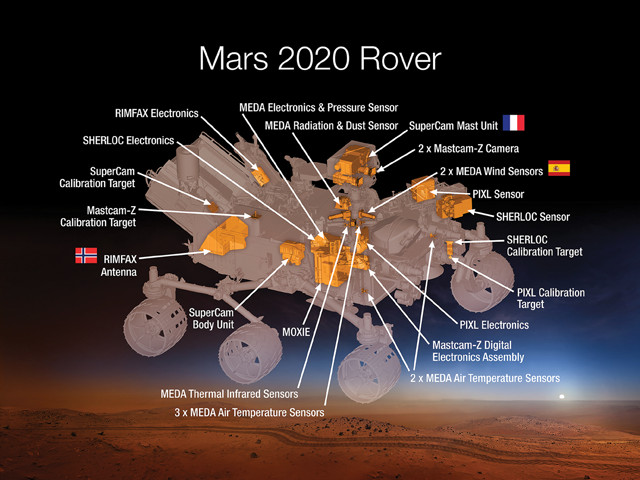
by Timothy Oleson Tuesday, September 12, 2017

NASA's Mars 2020 Rover will carry a variety of instrument payloads, including MOXIE (center of the illustration). Credit: NASA/JPL-Caltech.
The MOXIE (Mars OXygen In-situ resource utilization Experiment) instrument on NASA’s 2020 rover is designed to demonstrate technology that can generate oxygen from carbon dioxide in the Martian atmosphere. Scaled-up versions of the technology could one day be used to produce the large amounts of fuel needed to boost rockets back off the planet’s surface, as well as to create breathing oxygen for human settlements.
The system consists of three main components. A compressor collects and concentrates Martian air to about the density of air at Earth’s surface. This compressed air then passes through a solid oxide electrolysis unit, which, with the help of electricity from the rover’s radioisotope power source, electrochemically splits the carbon dioxide into oxygen and carbon monoxide. Meanwhile, sensors in the instrument allow the MOXIE team to monitor how well the system is working.
A predecessor to MOXIE, called MIP (Mars In-situ propellant production Precursor), was intended as one of the first direct attempts to prepare for future manned missions. But the Mars Surveyor 2001 Lander mission, aboard which MIP was slated to fly, was canceled, meaning MIP was never put into use. If MOXIE is successful, it will take the step that MIP was meant to, says MOXIE principal investigator Michael Hecht. And “there’s good reason to believe this is a more serious step onto that road,” he says.
With less than three years to go until the rover launches, a prototype of MOXIE has been built and debugged, Hecht says, and the next step is to build the hardware that will actually fly to Mars. “We know what it’s going to look like, we know how much it’s going to weigh, and we know how much power it’s going to use,” he says. So, “we can now project what that next generation [MOXIE successor] will look like. And that checks off one of our major objectives even before we’ve flown.”
MOXIE’s dimensions are akin to an oversized shoebox. Full-scale oxygen generators to support human missions on Mars would need to be roughly 100 times larger by volume than MOXIE, so about the size of a standard home air conditioning unit, Hecht says. The challenges for NASA, and those tasked with developing future generators, will be to design a setup to store oxygen after it’s produced — something MOXIE won’t do — and to figure out how to power the entire system. Whereas the 2020 rover’s power source puts out a little more than 100 watts, Hecht says that a full-size oxygen generator will take substantially more — closer to 25 kilowatts.
© 2008-2021. All rights reserved. Any copying, redistribution or retransmission of any of the contents of this service without the expressed written permission of the American Geosciences Institute is expressly prohibited. Click here for all copyright requests.